Have you ever tried oden? It is a delicious and nourishing Japanese dish that is made with various ingredients cooked in a flavorful broth. Oden is especially popular in the cold season, as it keeps you warm and cozy. You can find oden at many places in Japan, from home kitchens to restaurants to convenience stores. Oden also has a rich and diverse history and regional variations, showing the different aspects of Japanese food culture. In this article, you will discover more about oden, such as its origin, ingredients, recipe, types, and etiquette. If you are looking for a easy and satisfying way to enjoy Japanese cuisine, oden might be the perfect choice for you.
Introduction to Oden
Oden (おでん) is a boiled kind of Japanese food and classified as a hot pot dish (nabemono). Locals make this Japanese food by seasoning the soup stock taken from bonito flakes and kelp. Then, locals add lots of ingredients based on what they want. The types of oden vary from region to region and also from homemade.
This Japanese food is indispensable to those who love to have sake and this is an important dish to Japan. This dish is rich in regional colors as well as different flavors and ingredients for each household. Locals all over the country use local specialties for soup stock, seasoning, and ingredients. This article will make you realize that there are many things that you should know about this special dish, Oden.
Etymology

The meaning of the oden name in Japanese came from its original form, “Dengaku (田楽)”. The name was also shortened from dengaku to ‘den (田)‘, adding the honorific ‘o (御)‘, becoming the oden (御田)sold all over Japan today.
What is Oden?

Oden is a traditional Japanese food throughout the different regions of Japan. It is an indispensable dish to Japanese people, especially those who like sake. Additionally, locals classify this as a hot pot dish and are one of their boiled foods. Locals simmered this for a long time with kelp and bonito flakes and add satsuma-age, hanpen, grilled chikuwa, tsumire, konjac, radish, potato, gammotoki, chikuwa, suji (Gyu suji), boiled-eggs, and various other ingredients.
The types of oden vary from region to region and also from homemade. Oden is rich in regional colors as well as different flavors and ingredients for each household. It depends on the ingredients but locals add various oden seeds to the soup after pre-boiling and oil removal. The variety of seeds and soups varies greatly depending on the region and restaurants. They use it from cheap confectionery shops to food stalls, specialty shops, convenience stores, and good Japanese restaurants. You can also cook this at home and cooking books on home cooking often show how to make it. This dish is often a feature on TV cooking programs and travel programs.
History of Oden

Most records date the first form of Oden (おでん) back to the Muromachi period (1336-1573) to which grilled tofu would be serve with a serving of miso paste. Thanks to their resemblance to dengaku-hoshi (田楽法師, professional dengaku entertainers who used sticks to perform), this dish came to be known as “dengaku”.
Moving forward to the Edo period (江戸時代, 1603-1868), nameshi-ya (菜飯屋) began serving dengaku with a serving of rice boiled with greens and konnyaku, a gelatinous block made from an East Asian yam. The Japanese population in Edo then began simmering dengaku together in the same broth, creating the precursor to the dish we know today. The dish gained popularity as a snack thanks to yatai or street carts that would sell the dish alongside a pot of warm sake, adding ingredients to the broth on a per-order basis.
Oden as we know it today only really came to form in the late-Edo period/early Meiji period as restaurants began serving the dish. With the rise in popularity of fish paste products and what happened to the Great Kanto Earthquake of 1923, the dish became a more diverse dish and a dish with regional variations.
Standard Ingredients of Oden
Radish
Speaking of this dish ingredients, one of the standards is “radish” that many people think of first. When you simmer it, it absorbs the dashi stock so it is use not only for the dish but also for hot pots and simmered dishes.
Konjac
“Konjac” has a protagonist-class presence when added to oden, even though it is not a conspicuous ingredient. In addition to plate konjac, locals also add shirataki noodles and thread konjac to the dish. The trick is to make diagonal cuts so that the oden soup stock is well-absorbed.
Boiled egg
Eggs are indispensable for oden fans. Many people like to divide the yolk in half and eat it while melting the yolk in the soup. Egg yolks are hard-boiled and soft-boiled, but boil them for 12 minutes for hard-boiled eggs and 6 minutes for soft-boiled eggs.
Chikuwa
Chikuwa is the most popular kneaded product in oden. It is also one of the standard ingredients. However, if you want to put it in the dish, you have to choose one that is as large and thick as possible.
Hanpen
When it comes to cooking with “hanpen,” many people think of oden first. Like chikuwa, it is indispensable for this dish. The fluffy taste of hanpen is easy to discover and loses its shape, so you can just sprinkle it with a quick soup just before eating.
Vegetable Ingredients of Oden
Potatoes
The classic simmered potato, which goes well with oden. The characteristics differ greatly depending on the variety.
Carrot
All the ingredients to put in oden, such as radishes, pastes, and eggs, have no color. Adding carrots will increase the nutritional balance and make the inside of the pot gorgeous.
Tomato
Boil the tomatoes stripped in hot water over low heat for 10 to 15 minutes, and the result will be good.
Shiitake
Shiitake mushrooms are a staple of hot pots, but for some reason, locals don’t know them as oden ingredients. Not to mention the taste of the mushroom itself, the umami from the mushrooms melts into the dashi stock, creating a very elegant taste.
Taro
Taro is similar to potatoes, but you can enjoy a different texture. The sticky taro is hard to cool down, so please try it in cold weather.
Meat Ingredients of Oden
Beef tendon
Just add beef tendon and the gorgeous feeling of oden will increase sharply. The familiar way to eat is to boil it quickly, cut it into bite-sized pieces, and put it on a skewer to finish it.
Chicken wings
The chicken wings with outstanding dashi stock in oden soup. Chicken thighs, breasts, and chicken breasts are also suitable, but we recommend chicken wings that do not become dry even when cooked for a long time and have a dashi stock.
Pork ribs
When making oden as a side dish, juicy pork ribs are perfect for such people. The point is to buy blocks instead of slices and slice them into thick slices like kakuni.
Sausage
Sausages are becoming more and more popular at convenience stores. It’s a material that doesn’t easily connect with Japanese food, but the sausage with crispy skin and juicy inside is a perfect match.
Roll cabbage
It’s also popular to put roll cabbage in the oden ingredients. Unlike simmering in tomato or consomme soup, you can enjoy Japanese-style roll cabbage easily.
Seafood Ingredients of Oden
Octopus
The octopus, which is soft and plump and soaked in soup stock, is excellent. If you add it as it is, the soup of oden will turn red, so the point is to boil it for about 1 minute before adding it.
Squid
It’s standard to put an octopus in oden, but squid isn’t known for some reason. Some people like squid more than octopus, so it can be delicious. If you heat it all at once, it will harden, so the point is to simmer it over low heat.
Clams
It’s a little surprising combination, but it’s a dashi-rich clam that makes the taste of the soup much more delicious. Add this one at the same time as the paste because the meat will easily become hard and small.
Crab
Why don’t you make oden with crabs on special days such as New Year’s? Even in Kanazawa-style one, which is famous in Ishikawa Prefecture, it is standard to put crabs in it.
Fishball
Tsumire, which is a combination of minced sardines with potato starch, goes well with oden. The fish-based soup stock that is unique to fish comes out, and the oden is with a mild and gentle taste.
How to Make Japanese Food Oden?
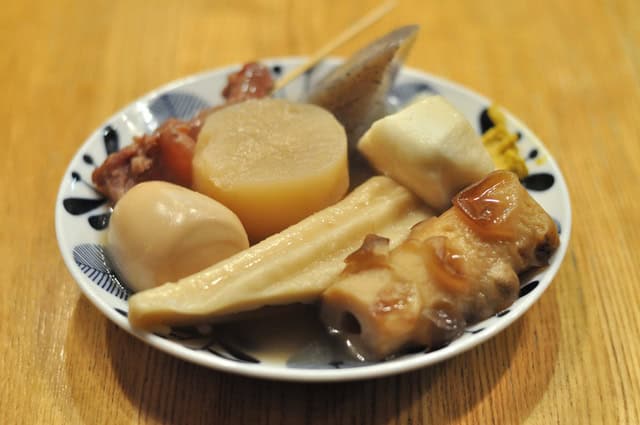
You now have options to choose from when it comes to knowing the ingredients of this dish as Japanese food. Now, we will get to know how to make oden as Japanese food.
In a donabe (earthenware pot) or a large and deep pot, add dashi (Japanese soup stock) and the rest of the seasonings for oden broth. We recommend using a thick soup stock for oden, using more bonito flakes than usual, and slowly simmering for 5 to 6 minutes. Add soy sauce, mirin, sugar, and salt to the pot. (It depends on the number of salty ingredients such as paste)
Cut all the ingredients into bite-sized pieces and skewer them on a stick. Combine the ingredients for the soup in a large pot, then add the radish, potatoes (May Queen), fried tofu, konjac, and eggs first. These are ingredients that you want to add flavor to, and that does not easily crumble even when boiled for a long time. When it boils, reduce the heat to extremely low and heat it for 50 minutes.
After 50 minutes, add paste, taro, boiled beef tendon, etc. and simmer for about 10 minutes, then turn off the heat. The principle is that when the broth cools, the ingredients tend to soak into it so remove the oden pot from the heat. Wait until it cools, and then reheat it before eating.
Regional Variants of Oden
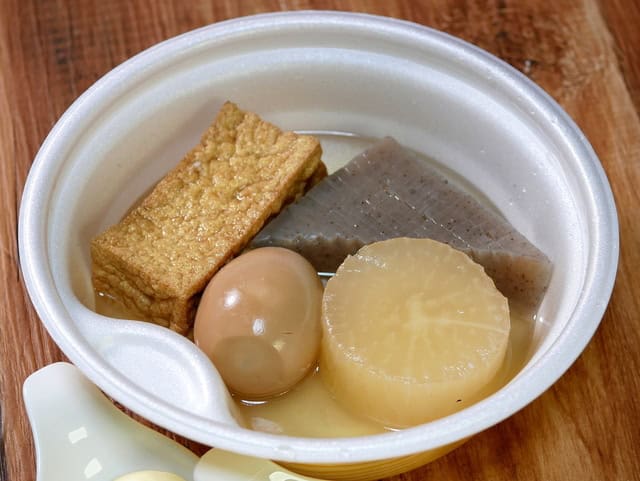
Kansai Area
Osaka coexists with “Kansai-style” with transparent soup and “Kanto-style” cooked with bonito and soy sauce. Moreover, in Kyoto, locals serve tofu, Kyoto vegetables, and ginkgo nuts. Himeji Oden is famous for its sauce with ginger soy sauce.
Kyoto-style
Oden with a light color made from kelp and light soy sauce soup, tofu such as tofu, hirozu, and yuba, and Kyoto vegetables such as Shogoin daikon and shrimp potatoes.
Osaka-style
Beef tendon and octopus are indispensable ingredients. Speaking of Osaka, koro-saezuri was the standard ingredient, but due to soaring prices, some households add beef tendon and chicken and serve it richly.
Himeji-style Oden
Himeji oden is to eat oden stewed with burdock rolls and beef tendon with ginger soy sauce.
Tohoku Area
An area where you can eat a wide range of Miso Dengaku along with stewed oden. The ingredients are wild plants such as bent-root bamboo and niosaku, and shellfish such as mussels.
Aomori-style
Oden is a well-balanced fish cake with bamboo shoots and scallops. Locals eat it with ginger miso sauce made from Tsugaru miso (rice and red miso). White konjac is also a typical ingredient in Tohoku-style.
Sendai-style
It features ingredients such as root-curving bamboo and saury dumplings and a refreshing soup stock. It’s easy to get ground saury, so some families put it in the shape of dumplings.
Akita-style
Oden is full of flavor with sweet seasoning on the stock of grilled sardines, kelp, and dried shiitake mushrooms. Locals characterize this by local wild vegetables called Niosaku, and the Akita style is to arrange the ingredients in large sizes.
Kanto Area
Typical ingredients include “hanpen,” “streak,” and “fish ball,” which are kneaded products. Additionally, “chikuwabu,” which is made by adding salt and water to the flour and making it into a kneaded stick. An area where the old-fashioned “Kanto style” and the “Kansai style”, characterized by its clear juice, coexist.
Tokyo-style
Old-fashioned oden with rich soy sauce and dried bonito flakes. “Sakura rice” cooked in salty sauce goes well with it. Some of this dish specialty stores use light soy sauce.
Chubu Area
You can see a wide variety of this dish, including Shizuoka, which features black hanpen and black soup. Some of it are Aichi, which coexists with miso stew, miso dengaku, and Kanto cooking, Iida, which features green onion sauce, and Toyama and Kanazawa.
Iida-style
Meanwhile in Iida, you should eat oden with a generous amount of green onions and bonito flakes and sprinkle with a tasty soy sauce. Iida City, Nagano Prefecture was the production center of green onions, which is one of the reasons why this sauce was born.
Kanazawa-style
A gorgeous oden locals make by boiling ingredients such as mussels and carrots in clear soup with kelp. There is also a specialty store that offers crab faces (crab shells with crab meat).
Shizuoka-style
Locals make the dish by boiling skewered ingredients such as black hanpen, narutomaki, beef tendon, and pork offal in rich black soup. The Shizuoka style is to sprinkle dashi powder (sardines and bonito powder and green laver) on it.
Okazaki-style
Okazaki-style Dengaku is baking tofu, applying Hatcho Miso-based sauce, and adding Japanese pepper. “Nameshi” mixed with green vegetables such as radish is indispensable for this Dengaku.
Nagoya-style
The sweet and spicy juice made from Hatcho Miso, Sanon Tou, sake, etc. is famous for its unique taste and aroma that soaks into pork offal, beef tendon, radish, and kakufu. Moreover, many oden shops and restaurants mainly serve this in Nagoya city.
Chugoku Area
There are differences in seasoning, ingredients, and sauce between the Seto Inland Sea side and the Sea of Japan side. Typical examples are Takamatsu Oden, which is one of the two types of oden. Additionally, Matsue Oden, which has a large proportion of specialty stores and its ingredients has leaves and shellfish.
Matsue-style
Oden with abundant seafood, stewed with dried chikuwa fish. Decorate with garland chrysanthemum and auction. Matsue City also held the Oden Summit in the past.
Takamatsu-style
Many Sanuki udon restaurants in Takamatsu City have an oden corner, and you can eat them with two types of miso sauce (sauce made with white miso and mustard, and sauce made with red miso and sugar).
Kochi-style
A simple and rich oden made from Kochi’s famous bonito flakes and chicken wings, stewed with Jakoten and red kamaboko. There is also a specialty store that sells both dark and light soy sauce.
Kyushu Area
An area which locals know for its rich taste. In Hakata, “Gyoza-maki” made by wrapping dumplings with minced fish and fried, is famous.
Nagasaki-style
Their oden is popular for the richness and sweetness of the fish soup stock and the paste. It features a dragon’s eye containing a whole egg. Locals included in this dish a lot of kamaboko and chikuwa on skewers.
Fukuoka-style
Meanwhile, in Hakata, “Gyoza-maki” made by wrapping dumplings with minced fish, is a specialty. Additionally, in Kokura, they put cabbage in with mochi. The area around Mojiko is affected by Honshu. Some udon shops in the prefecture have a corner for this dish.
Aso Takamori Miso Dengaku
It features a refreshingly sweet Miso Dengaku made from wheat miso, brown sugar, mandarin orange peel, and Japanese pepper. In Aso, in addition to tofu and konjac, ingredients such as char and the famous Tsuru no Koimo are also characteristic.
Kagoshima-style
Kagoshima, which is famous for pork, has a pork base as well. Moreover, the characteristics are the umami from pork, the sweet juice seasoned with wheat miso, and the soybean sprouts, fried and thick fried ingredients. They based the recipe on the traditional dish “pork bones”.
Okinawan-style
Locals make their oden with its rich flavor of pork legs (tebichi). In addition, sausages and greens are indispensable. The development of this dish is said to be after the war, but there are surprisingly many oden shops in Okinawa, the southernmost point.
Where to buy Oden?
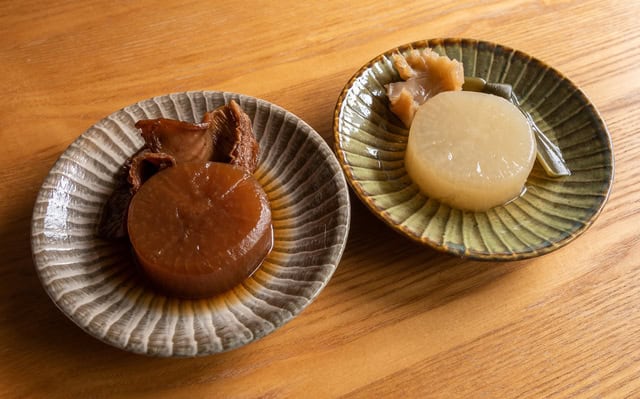
Furiuri (peddler) in the Edo period
In Edo and Kamigami, the name “Kami-kan Oden” became popular.
Oden Shop
Oden shops often serve them as a side dish for sake at a small drink bar called “Odenya.” As of 2014, Kanazawa City had the largest number of oden shops per resident in Japan. Most commercial fish cake pots are rectangular, with compartments for each ingredient.
Stall
In the past, “Oden-ya,” a stall, opened all over town at night to provide a place for drunk people to relax. However, it has been decreasing since the 1980s. At present now, there are some stalls selling oden as a store for festivals.
Storefront
There were many storefronts where large pots of oden are in front of shops such as dagashi shops and restaurants. Store owners boiled it in shichirawa and stoves, but they became obsolete after the 1980s. Some shops still exist in Shizuoka City.
Convenience Store
The above-mentioned places are stewing at the front of the restaurant. Now in the present time, you can also now stew oden at the cash register side of a convenience store.
Supermarket / Grocery stores
Canned goods such as canned oden are manufactured and sold at stores and vending machines. However, since the 1990s, many products have been sold in retort packs using transparent laminated film bags.
What are the health benefits of eating Oden?
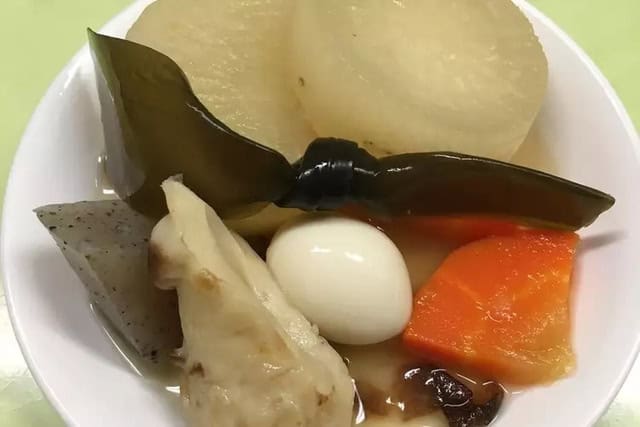
“Oden”’ includes hanpen, chikuwa, eggs, and wild ducks. It contains a lot of high-protein ingredients. You can also take in various nutrients at once by eating them with kelp and konnyaku. It has 445kcal, lipid, carbohydrates, calcium, iron, and protein. It also has dietary fiber and vitamin B. Another attraction of this dish is that it contains ingredients that are easy to digest.
What does Japanese oden taste like?
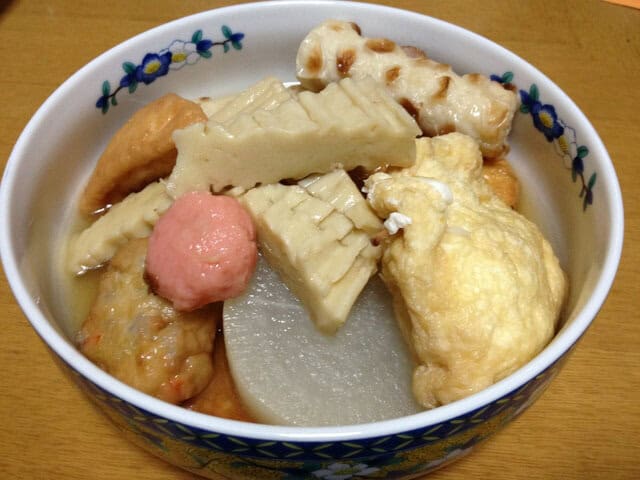
Are you curious about what Japanese oden tastes like? The taste is a little bitter and eye-watering kind of spicy when eaten raw. Simmered in an oden soup for a long time, however, it’s a whole different vegetable.
What is oden serves with?
Oden is typically serve with Japanese mustard called karashi, so add a small amount of karashi to each bite of this dish and enjoy this delicious meal. You can eat it with miso on the daikon, fish cakes, and boiled eggs that are simmering in dashi.
What other Japanese food is similar to Oden?
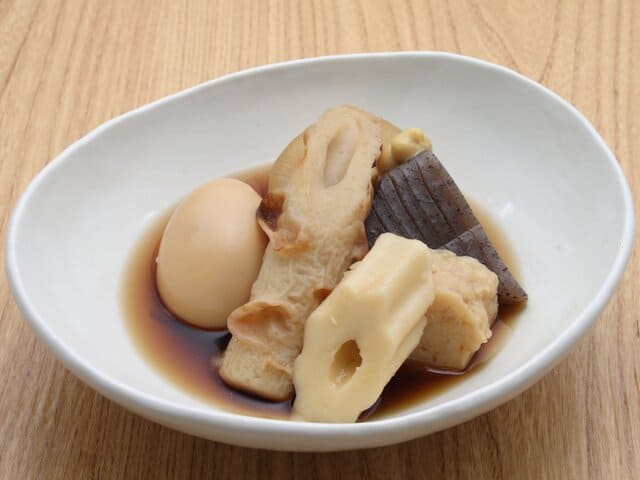
Indeed, the Japanese enjoy a wide variety of hot pot dishes called nabemono. Oden is one of the nabemono dishes that the Japanese know. Some of the popular nabemono dishes are Sukiyaki, Negima Nabe, Shabu-Shabu, and many more.
Recommended Oden Japanese Restaurants
Here are some recommended oden restaurants in the Tokyo area that serves an exquisite and delicious oden.
Oden and Japanese sake Kashiwa
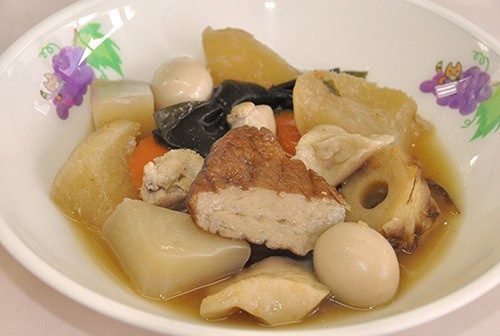
An izakaya where you can enjoy crispy fried chicken tempura and delicious oden with an arrangement of the authentic taste of Oita. Enjoy it to your heart’s content with a selection of sake and Oita shochu. In addition, a casual space that is easy for one person to enter is recommended not only for a drink after work but also for dates and banquets with a small number of people.
Otafuku

The long-established oden shop “Otafuku” in Tokyo was founded in 1918 and is a famous oden specialty store listed in the Michelin Guide. In addition to oden, various menus go well with sake, and it is a famous restaurant that is gaining popularity.
Shimbashi Otakou

Otakou, a long-established oden specialty store in Tokyo founded in 1918. It is a well-known store that is popular in Tokyo as it offers delicious Kanto-style oden with a strong flavor. There is a private tatami room that can accommodate both small and large groups, and you can enjoy delicious oden in a retro space where you can feel nostalgia. Additionally, it has a variety of menus such as sashimi, grilled food, and fried food that can fill your stomach. The shop also has a wide range of drinks such as beer, local sake, and shochu.
Konakara
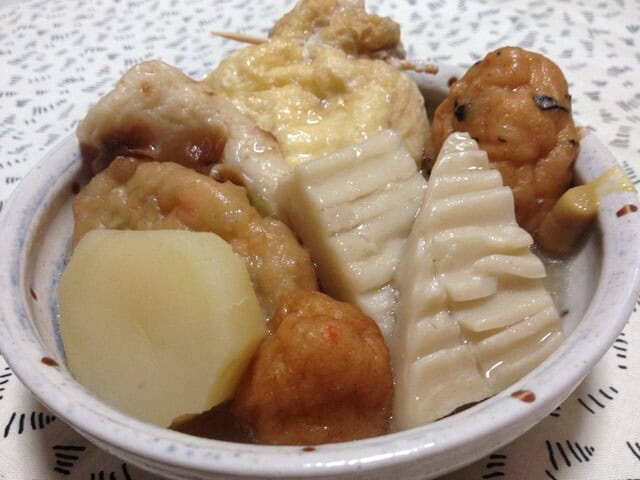
“Konakara” is a famous oden shop located on the 5th floor of the Shinmaru Building in Tokyo. It is where you can enjoy delicious oden made from shiitake mushrooms, dried bonito flakes, mackerel flakes, and kelp. Each oden seed is carefully handmade, so you can enjoy a unique flavor and texture that you can’t taste at other stores. In addition to this dish, there are also menus such as “Kakiponzu”, “Grilled Nagaimo” and “Sashimi of Yuba” that go well with sake.
Kashimin
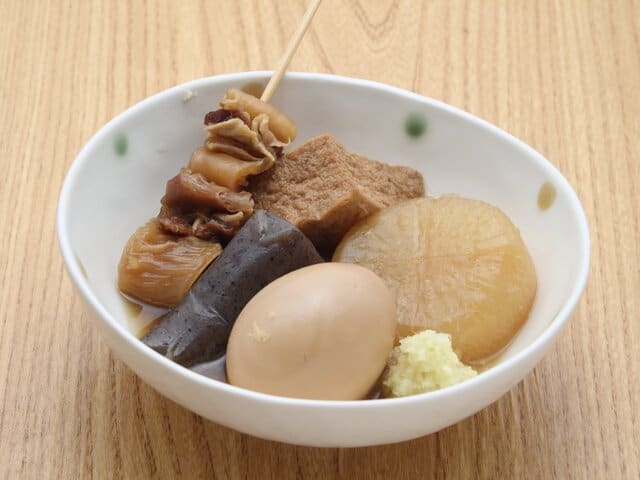
It is a famous specialty oden shop in Tokyo where you can taste delicious chicken soup oden based on carefully selected chicken skin and various vegetables. There is also an oden hot pot course offered only for lunch and a mushroom oden hot pot course offered seasonally. Moreover, it is a famous izakaya-style oden restaurant where you can enjoy more than 22 types of local sake. Moreover, there are plenty of menus that go well with sake.
Conclusion
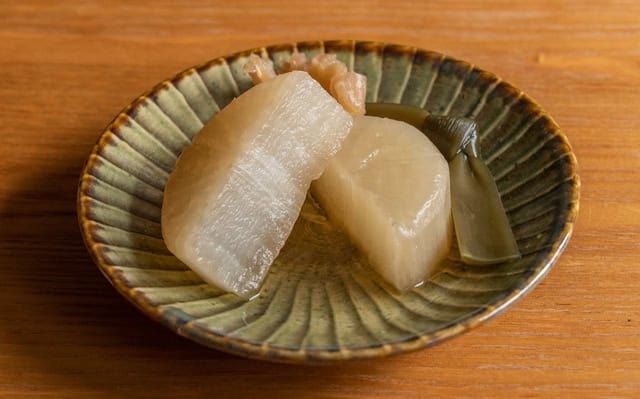
There are various types and flavors of hot pot dishes all around Japan. However, the most common one is available during the winter and most regions in Japan have oden. Oden is one of the oldest fast foods in Japan and the predecessor of oden was miso dengaku. It is a traditional winter dish in Japan that stews vegetables and fish cakes in dashi Japanese stock. It is Japanese comfort food at its finest. It’s so good but this dish is a bit hard to try if you’re unfamiliar with Japanese foods.
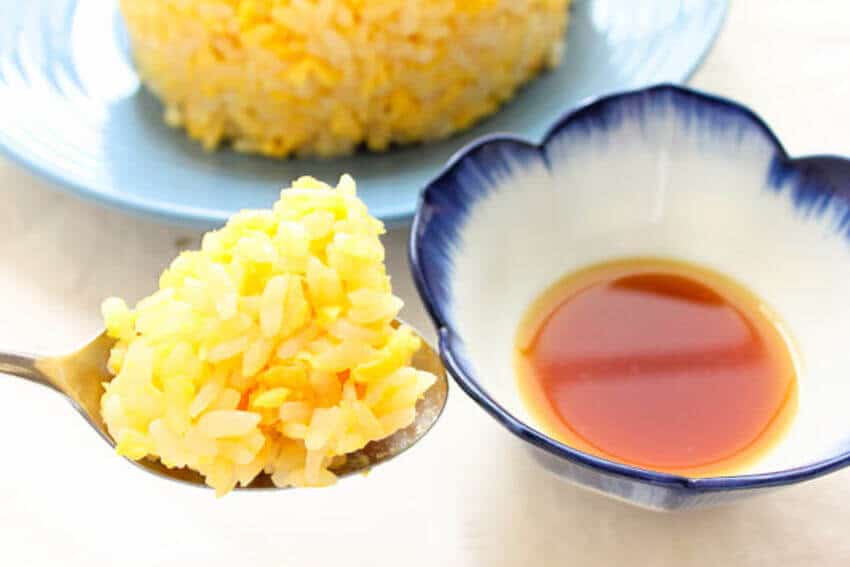
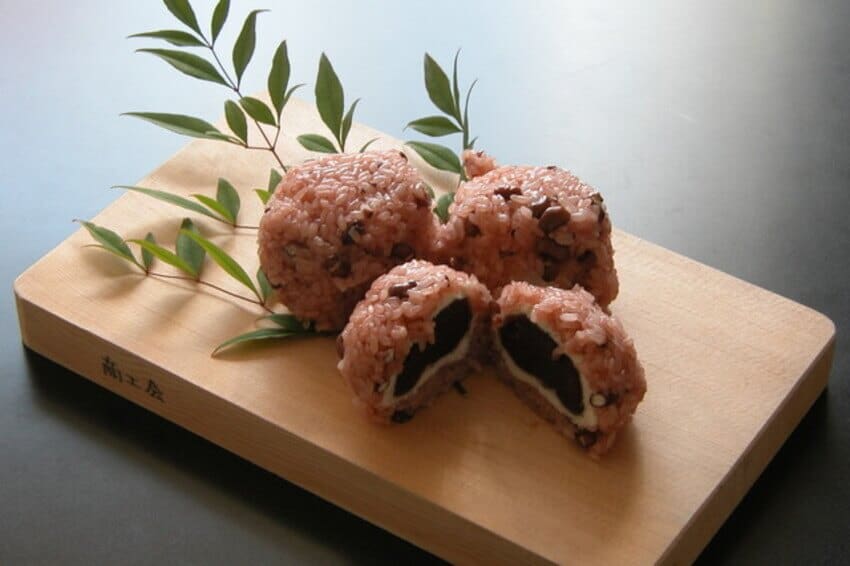
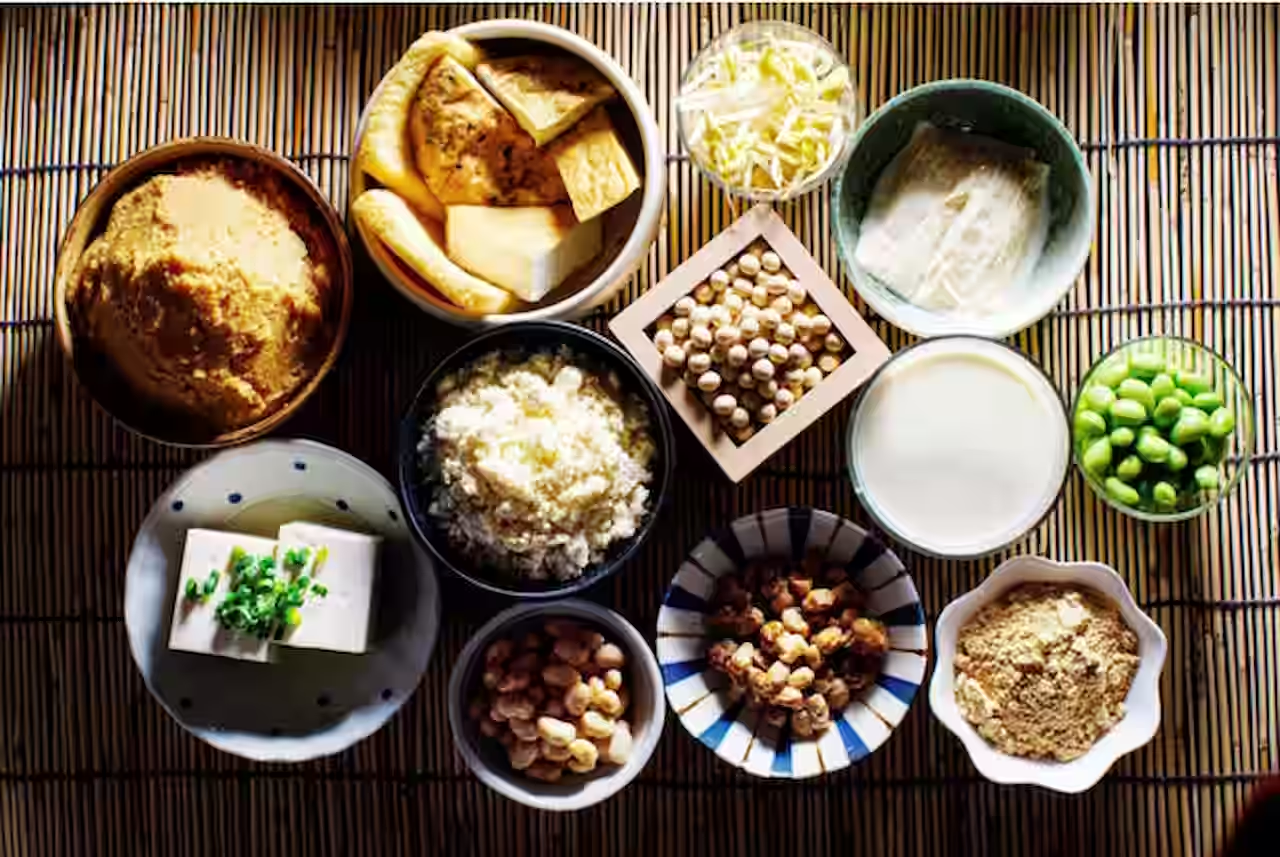



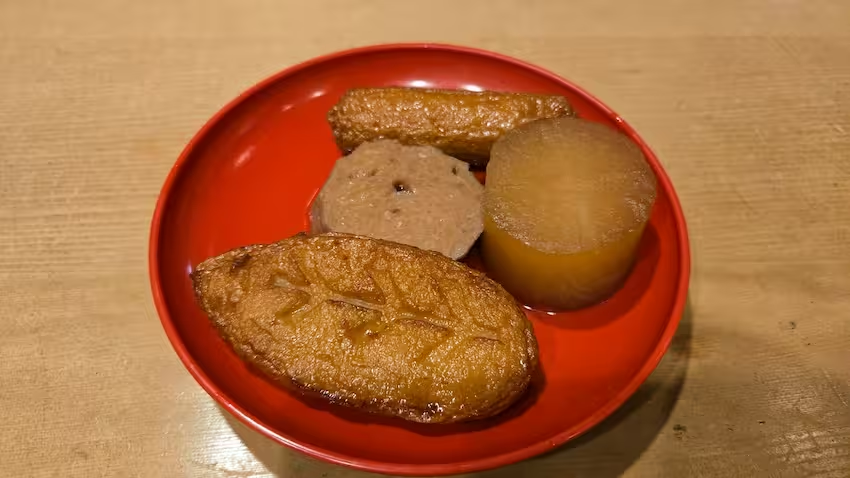
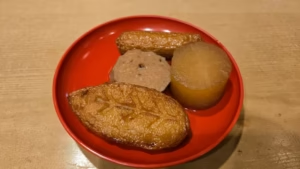
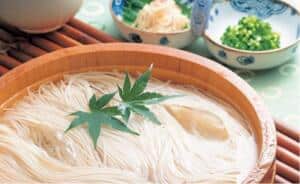
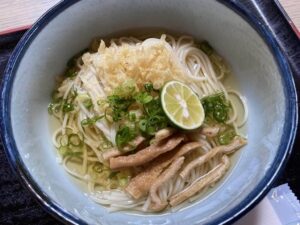
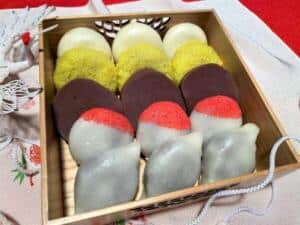
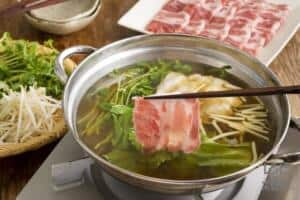
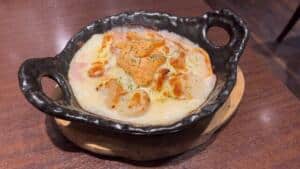
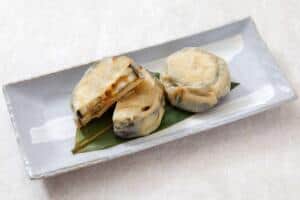
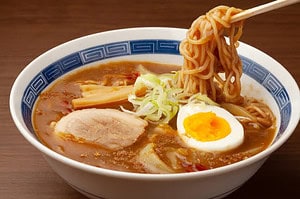
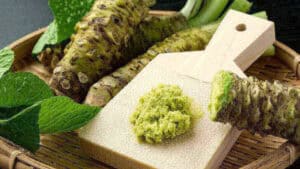
Comments